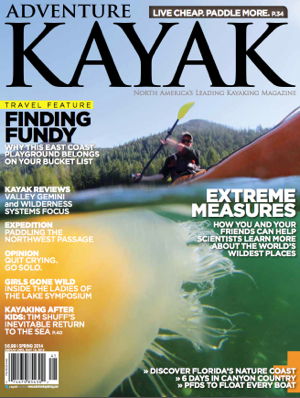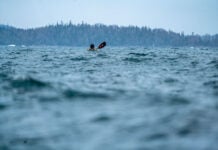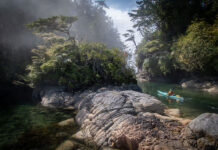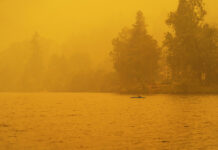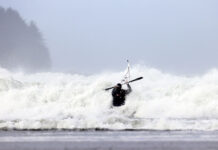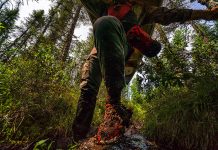“I wouldn’t have thought it possible to cry so much and for so many days on end. I cried because it never became easy. I cried because I had no one with whom to share the beautiful moments, and no one to encourage me. I cried because my resolve, my strength, my resourcefulness had to be enough and I was scared they would eventually be inadequate.”
This is one of the more thumb-sucking passages from Going Alone, a collection of essays from women adventurers. I read this and 19 other deeply personal accounts of solo wilderness experiences in preparation for my own extended voyage—seven weeks on the open coast, alone.
I felt ready. Ready to be lonely, fearful and weepy. But beneath the forlorn blinking of an automated lighthouse, alone on a tiny island far offshore, I felt more perplexed than distressed. I waited for the crushing loneliness that would constrict my chest, stealing my breath and my confidence. I fed warm carrot soup into a hollow stomach and watched, quite dry-eyed, a heartbreakingly beautiful northern sunset.
“Aren’t you scared?” asked nearly every person I encountered. It was not an unreasonable question. I knew all too well the hazards of coastal touring in remote areas by oneself: unpredictable, fast-changing weather and sea conditions, long stretches with difficult or no landings, frigid waters, defensive mama bears, lost or damaged equipment, making poor decisions. In my years on the lake, I’d lost count of how many times I had watched the search and rescue Hercules circling the steely skies above foam-streaked waters. I had witnessed forensic divers searching for the body of an experienced solo paddler who’s final decision – to go rather than to stay – had proved deadly.
But when I inventoried the dozens of emotions I experienced every day, fear was seldom amongst them. Most of the time, I felt calm, at ease. An expedition, I have always believed, is open to anyone who dares to depart with hatches and imagination full. Even if your boat—like my own 16 feet of rotomolded yellow plastic—is more weekend warrior than devoted tripper. Even if so are you.
I wasn’t afraid of the dark. I didn’t lie awake fretting over the night noises beyond the walls of my silnylon sanctuary. Even the unpredictable moods of the great, restless waters didn’t scare me. But I scared myself a few times. In six-foot waves on a remote five-mile crossing. In a clumsy slip beside a two-story drop to unyielding bedrock. In the reflection of a mirror in a campground washroom after 43 days on the water.
Perhaps solo kayak expeditions would enjoy broader appeal if more people learned to differentiate between irrational fear and actual risk.
My gut twisted and my skin prickled the evening a man appeared from the bushes near my tent. My hands were so numb on the aforementioned crossing I wondered if the paddle would slip from my grasp. Falling to my knees on the far shore, I thanked the evergreen hills, the copper cliffs and the howling wind for sparing my foolish self.
It’s healthy to experience fear in these situations, as long as you can rein it in and keep enough wits to make your way back to safer circumstances. Our fight-or-flight response—unchanged through millennia of evolution—is what has kept us alive in the face of saber-toothed tigers, thunderstorms and Simon Cowell.
It is an irrational fear that is problematic. The clamoring, claustrophobic fear that doesn’t bow to fight or flight. Fear of the dark beyond your vestibule. Fear of being alone. Fear of growing old, or sick, or even just less willful. Fear of being afraid.
Fear is a strange bedfellow. Like a good story, a carefully crafted paranoia is rarely hampered by the truth. I have friends from the country who are terrified of the city. And urban friends who fear if they venture too far beyond city limits, they are sure to meet a slow painful end, if not from wolves or exposure than from an equally silent killer, boredom.

This fear of nothing to do is a surprisingly prevalent one. Or perhaps it is not so surprising. After all, we live in the most hyper-stimulated, over-programmed place and time the world has ever known.
Here’s a typical conversation, this one with a curious passer-by I met outside a campground office:
“You’re out here alone?” asks curious. “Yes,” I reply.
“By yourself?” curious confirms. “Uh-huh.”
“What do you do all day?” A refreshing break from the “Aren’t you scared?” line of questioning.
“Well, I paddle until late afternoon, then I make camp, cook dinner, explore the beach, jot down my thoughts…”
“Sure, sure, but after all that—don’t you, y’know, get kinda… bored?”
“Nah, I like having time to just sit and think and quietly observe nature,” I say.
Open-mouth stare.
“Besides, I’m quite tired by the end of the day,” I continue awkwardly, “I go to sleep pretty early.”
“Oh yeah, of course,” curious nods. It’s the first thing I’ve said that makes any sense. The ability to quickly summon unconsciousness is evidently the only thing that’s kept me alive in the absence of smartphones, Twitter feeds and Duck Dynasty downloads.
As Annie Getchell, a fellow solo sea kayaker, writes in Going Alone of trying to describe her experience to friends post-trip, “How do I explain about returning to stimulation instead of being?”
Perhaps solo kayak expeditions would enjoy broader appeal if more people learned to differentiate between irrational fear and actual risk. If you need evidence our sensors are screwy, look no further than the millions of dollars spent every year preparing for a zombie apocalypse. How is it acceptable to worry about the un-dead, but I am crazy to paddle by myself?
The dawn of the dead notwithstanding, most of us face relatively few mortal threats in our day-to-day lives. Immersing yourself in a wild environment, develop- ing the mindfulness to safely negotiate its hazards, finding the awareness that comes without constant artificial stimulation, acknowledging your apprehensions and calmly setting them aside—all of this is immensely and uncommonly rewarding.
In the words of another solo woman adventurer and writer, Jill Frayne, “To be in undisturbed places is good for humans and, at least once, you have to go alone. Nature brings us to ourselves.”
On the subject of fear, Frayne continues, “Sometimes camping alone puts an ache in my throat, a feeling close to homesickness. But I don’t think fear explains it. I think the feeling has to do with nature herself, the force of her presence. Nature gets us down to size, disquiets us, makes us anxious and lonesome and thrilled.”
Am I scared? The only thing I truly fear as a kayaker is the day that no one paddles alone because it’s too dangerous—or worse, too boring.
Editor Virginia Marshall does have another fear: tripping without chocolate. But she insists it is completely rational.
